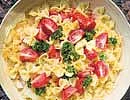

ORETTA ZANINI DE VITA, the Italian food historian, seems to have a tool for every pasta: a centuries-old ravioli cutter, a wooden stamp that mints pasta like coins, a chitarra for creating thick strands of tagliatelle.
On a recent morning, as she leaned over a custom-made poplar-wood board and rolled out a simple dough of eggs and flour for a southern Italian-style strozzapreti, she took out a long, thin reed.
“If you don’t have a reed, you can always use an umbrella spoke,” she said cheerily, rolling flat strips of dough around the reed until the sides curled.
Not just macaroni
Zanini De Vita, a sprightly 73, has curly blond hair and bright blue eyes that light up when she gets animated — which is often. As she raced around her ground-floor apartment fetching ingredients and utensils, her white cotton smock trimmed with lace gave her the appearance of a cherubic altar boy.
Her conversation is as animated as her cooking. Her words flow like a river in full flood as she speaks about pasta, the subject of her latest book, The Encyclopedia of Pasta, which just appeared in English from the University of California Press, translated by the Rome-based food writer Maureen B Fant. Through hundreds of descriptions of pasta styles, with explanations of their origins and of how they’re made, the book places pasta in its social and historical context.
Indeed, in its 300-odd pages, The Encyclopedia of Pasta ranges from abbotta pezziende, a short pasta that means “feed the beggar” in Abruzzo dialect, to the zumari of Puglia, a long pasta traditionally added to vegetable soups.
In between there are the corzetti of Liguria and Piedmont, the little stamped-out coins; pi fasacc of Lombardy, which look like little babies in a papoose; avemarie, which cook for as long as it takes to say a Hail Mary; and several dozen variations of macaroni and ravioli. Each illustrated entry lists ingredients, provenance and how the pasta is traditionally served.
There’s gnocchi ricci, or curly gnocchi, a specialty of Amatrice in Lazio, the city famous for spaghetti all’amatriciana, which are made by kneading together one dough made with flour and eggs, and another made with flour, boiling water and salt.
The Marco Polo myth
The book also explodes a few myths. Do not think of mentioning the popular belief that Marco Polo had a role in the history of pasta. “Ma no,” Zanini De Vita said in a jovial paroxysm of outrage. “When Marco Polo came back they had been eating pasta in Italy for 200 years!”
Instead, she notes in her encyclopedia, dried pasta made with durum wheat was found in Italy, starting around AD 800. It was spread by the Muslim conquerors of Sicily, and by the 12th century the maritime republics of Genoa and Pisa marketed dried pasta.
“Documents exist to prove this, should there be anyone left — and it appears that there is — who still believes that Marco Polo introduced noodles into Italy in 1296 on his return to Venice from China,” she writes.
Inspired by the nuns
Zanini De Vita knows her pasta and her history. She was born in Bologna, the sine qua non of Italian culinary excellence. Her father was an architect and painter. Her mother died shortly after she was born, and she learned to cook from the nuns at the convent school where she was educated.
“I always left the study room to see what the sister was up to in the kitchen,” she recalled. The nuns taught the girls that their tortellini dough was thin enough only when they held it up the window and could see the nearby Sanctuary of the Madonna of San Luca.
Before agreeing to demonstrate her own pasta-making techniques, Zanini De Vita, who used to run her own cooking school and still teaches the occasional lesson, insisted it be known that The Encyclopedia of Pasta is not “a recipe book.”
She is correct; it is a social history disguised as a food book. A repository of collective memory, it shows a country so varied as to defy unification, and so poor for so long that pasta was a luxury for four-fifths of Italians until the prosperity that came after World War II.
Simply flour’ed
For centuries “pasta was a luxury, you ate it only inside vegetable soup,” Zanini DeVita said. In the southern Basilicata region it was eaten “once or twice a year: for Easter, Christmas and Carnival.” Flour was for the rich. “The poor wouldn’t even see it in paintings,” she said.
In a restaurant in Puglia, she once came across spaghetti di grano arso con le vongole or burnt-flour spaghetti with clams. It stems from the days when the poor would comb the threshing floor for crumbs left behind after milling, toasting what they found. “It has a slightly smoky flavour, and I have to say it goes very well with clams,” she said. “Now it’s a niche product. I suppose they make it by toasting the flour.”
The history of pasta is also the history of conquest. The orecchiette of Puglia, “little ears” that lovingly show their makers’ thumbprints, date back to the 13th-century domination of Southern Italy by the Angevins of France. “They resemble the crosets of Provence, which are still made in Piedmont with the same name,” she writes.
“In food there’s lots of regionalism,” Zanini De Vita said. “Everyone thinks he has the most authentic recipe.”
The rules for which kind of sauce goes with which kind of pasta can seem baroque — and by most Italian standards, surprisingly rigorously enforced — but for Italians they’re grounded in habit and common sense. A Bolognese sauce goes on a long pasta, a pesto on a short pasta, and heaven forbid you ever sprinkle cheese on a pasta with fish sauce!